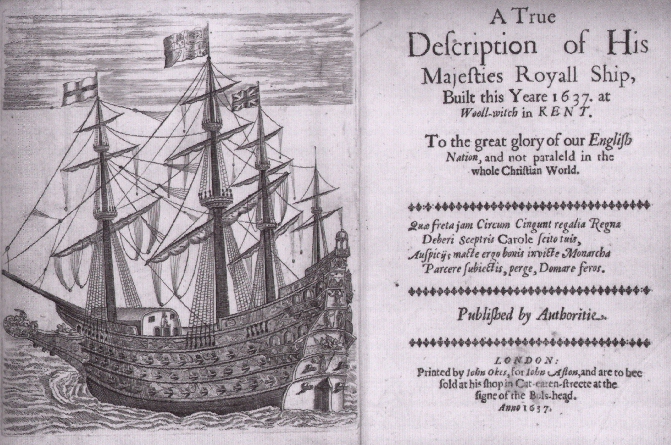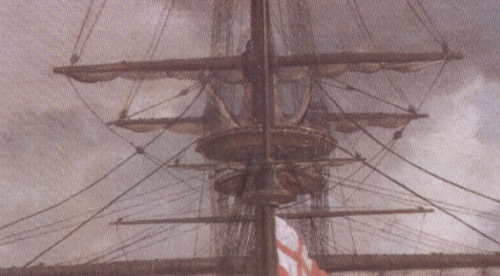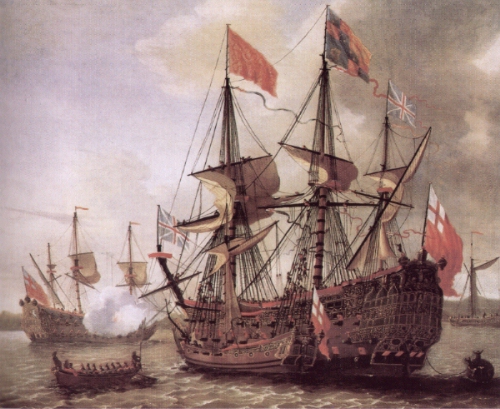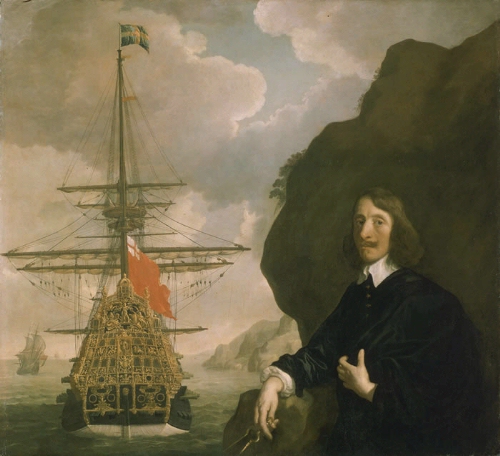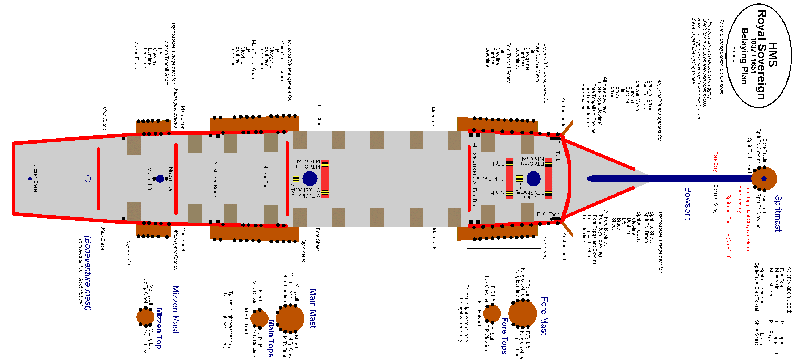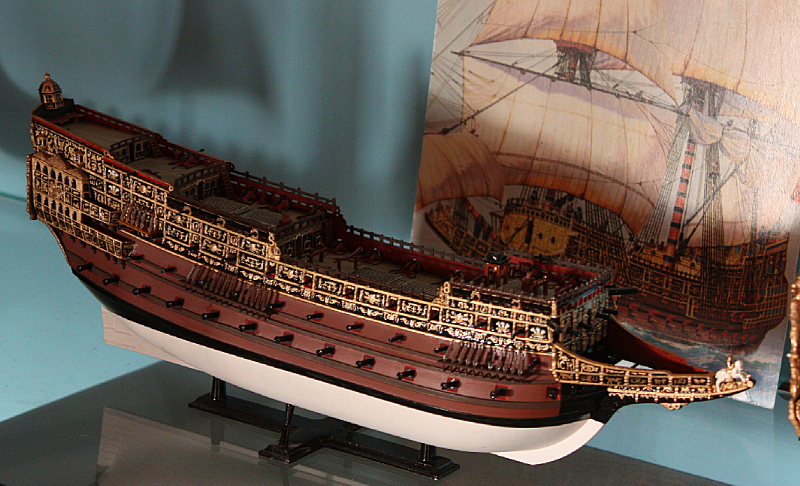Ship Modelling
Royal Sovereign [Sovereign of the Seas] (1637)
Type
Data
It was the first ship - and for a long time the only one - carrying royal sails on the 4th yard of fore and main mast. All other ships had only two or three yards on a mast. NOTE: this lent to reconstruction of fine miniature models as the first "tall ship of the world", but in real use, the ship sailed only with 2 yards (courses and topsails) like any other ship of her time. See evidences below. |
History
|
1637 built by Peter Pett, by the order of Charles I. He wanted to have the greatest ship ever built in the world. Name: "Sovereign of the Seas" 1637-1651 14 years demurraged, because the ship was too expensive to be lost in a battle. Instead, it was used as a representation of the Royal power in Chatham. She was also called the "Eighth Wonder of the World". Her overboarding baroque decorations was a challenge for other kingdoms, the French built La Couronne, the Dutch the De Zeven Provincien, the Swedish built the Wasa, the Denish the Fredrik / Elefanten, and so on. During that period, the "Royal client" of this ship was beheaded by his fellow countrymen, in the Revolution of 1649. But also Oliver Cromwell, who led the short living republic, had no plans with the ship. 1651 Great Repair: Removal of the "Topgallant Poop" and the Bonaventure mast. There is no timber that could withstand the salty seawater for such a long time. So the Great Repair was in fact a complete re-building. 1652 First War with the Netherlands. Battle of Kentish Knock; she hit ground, but was made afloat again. 1659 Repair: new figure head 1660 Renamed "Royal Sovereign", by Charles II., while the Royal reign has been reestablished. 1665-67 Second War with the Netherlands. She served as a "Ship of the Line" for the first time. Battle at St.James Day. 1672-74 Third War with the Netherlands. Again he served as a "Ship of the Line". By the Dutch she became nicknamed as "Golden Devil". Battles at Solebay 1672, Schooneveld 1673. 1684 "Great Repair": the keel was made longer and the hull wider. New Lion figure instead of a rider. The gallion was reshaped, less long but more rolling (as shown in the drawings by van de Velde). The long side galleries were rebuilt in a "modern" fashion, as can be seen on the HMS Prince (1670), which was the successor of the "Royal Sovereign". 1692 Battle of Barfleur against France, where she "met" also with the magnificant French ship "Soleil Royal" for a small quarrel... 1696 Preperation for another Great Repair. But then, she was totally destroyed by a fire. They say it was a forgotten candle in the galley... 1701 A new "Royal Sovereign" was built by Fisher Harding. Later in the Royal Navy, many ships were given this name... |
Decorations
|
The Royal Sovereign is regarded as the most magnificant sailing man of war
ever built in the world.
For this she was and is so famous, and is rebuilt
as a model many times today.
The incredibly rich ornaments of royal sailing men of war was a common pattern of the 17th century, expressing the power and wealth of the kings of Britain, France and other countries. This kind of luxory is utterly strange for us today...it is prooved that genuine gold leafs had been used!
|
Sources of Research
|
Reconstructions
Reconstruction of the Rigging
|
The known engravings and paintings are very helpful for this kind of research.
The most exact depiction seems to be the coloured engraving by John Payne.
We can identify many of the following details in it:
The Royal Sovereign is shown with 3, not 4 masts, so after her Great Repair of 1651. We cannot see the inner details behind the bulwarks. The other depictions also hide those details the same way, showing the same angle of perspective. But we can see that the main deck and the mizzen deck is entirely couvered by huge gratings. The two poop decks aft are open... Masts and spars:
Standing Rigging (Stays) of Bowsprit and Spritmast:
Sails and Running Rigging of Bowsprit and Spritmast:
Standing Rigging of the Fore Mast (symmetric for port and starbord):
Sails and Running Rigging at the Fore Mast:
Standing Rigging at the Main mast:
Sails and Running Rigging am Main mast:
Standing Rigging am Mizzen mast:
Sails and Running Rigging am Mizzen mast:
Ahead of the Poop Lantern waves the Royal Ensign at a big flag pole behind the Mizzen sail. There seem not to have been footropes for the yards. Instead, it is likely that the sheet rigging had been used for this purpose - very dangerous for the seamen there aloft! The engraving of Payne is very realistic: it shows the flaggs and pennants waving ahead, correctly in the follwing wind. So many other "unabled" artists made mistakes on other works... |
Reconstruction of the Rigging - with some Surprises ...
|
Apart from the Payne engraving, only two paintings show the Royal Sovereign entirely with all her riggings and sails. On these paintings, she only has two square sails per mast instead of the famous four.
These paintings are:
The graphic title page of the contemporary "True description" shows so many differences to the other depictions that even if this picture might have some historic value, the Royal Sovereign is very hard to recognize on it! At least we can see the Bonaventure mast... Topgallant sails were rare that time and they were only used in light winds. The tiny Royal sails had even less effect for the propulsion of the ship. They were invented as an eye-catcher for the people, who should admire the British Navy. Four yards at one mast ... wow! We do not know if the Royal sails ever had been used. At least, their name comes from this Ship, and another 100 years were to pass by until Royal sails were rigged again, on even bigger ships than the Royal Sovereign. Almost all magnificent models of the Royal Sovereign show her with 4 yards, for the same sake of making people say Wow! as 300 years ago. In reality, the usage of so many sails was unfamiliar to the seamen and so rather difficult. Maybe because of that reason, in 1637-51 the ship never left the port (except of parades, we do not know)! The reduction of the rigging may have been due to the catastrophic news about the Swedish Wasa sinking in 1628: with "too many sails set" (which was not the case actually), the Wasa was litterally "blown away" and capsized - and the open gun ports made her sinking fast. So, a too lofty rigging can be dangerous if You cannot handle it properly... |
Reconstruction of the Belaying Plan
My Personal ReconstructionAccording to my own researches about old riggings and belaying plans, the following reconstruction may come close to reality ...But of course, it is just a sophisticated guess - and my third version already :) Actually, there are many possible arrangements that I did not give an exact position here, but only some areas of "probability". The topsail sheets, course sheets and tacks are the only lines being most "certain". All the rest is speculation. The inclined modeller may find his/her own special solution ... |
Model Kits of the Royal Sovereign
The Airfix model kit, Scale 1:168?The Airfix kit of the Classic Ship series, the only known plastic kit of this ship. It is sold out long ago, but I had the luck to buy one of the last.
No, mine is not finished ... the rigging is missing, I spent much time on research. So far I have only made the hull:
This is how even most of the professional, contemporary models actually looked like. Sails were regarded "low priority" in comparison to the much more complex hull and its fittings. After all, any ships´ rigg would look pretty much the same over centuries, through all ranks. Ah, so, adding another yard, the "royals" ... so what? That was easy, and the royals were very rarely used for anything but impressing an landlubber by His Majestys´ Ship. BTW, it is reported that the "Sovereign of the Seas", later named "Royal Sovereign", has NOT been the first ship carrying "royals" ... they were just too few records about those riggings to be noticed... |

